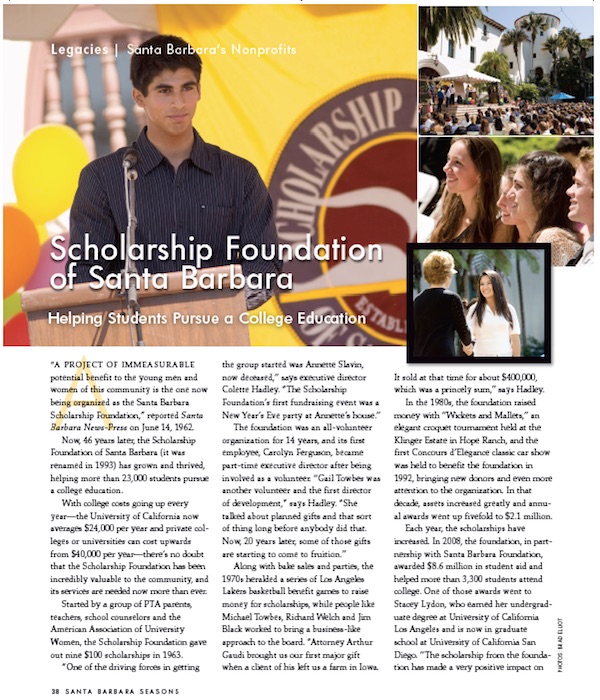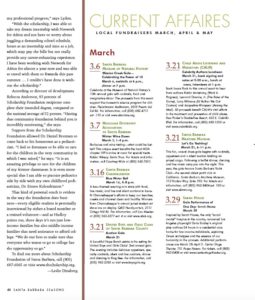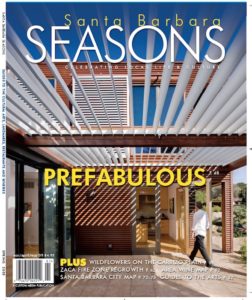
Scholarship Foundation of Santa Barbara, photos by Brad Eliot, story by Leslie Dinaberg. SB Seasons spring 2009.
Helping Students Pursue a College Education
“A project of immeasurable potential benefit to the young men and women of this community is the one now being organized as the Santa Barbara Scholarship Foundation,” reported the Santa Barbara News-Press on June 14, 1962.
Now 46 years later, the Scholarship Foundation of Santa Barbara (it was renamed in 1993) has grown and thrived, helping more than 23,000 students pursue a college education.
With college costs going up every year—now the University of California averages $24,000 per year and private colleges or universities can cost upwards from $40,000 per year—there’s no doubt that the Scholarship Foundation has been incredibly valuable to the community and its services are needed now more than ever.
Started by a group of PTA parents, teachers and counselors, and the American Association of University Women, the Scholarship Foundation gave out nine $100 scholarships in 1963.

Scholarship Foundation of Santa Barbara, story by Leslie Dinaberg. SB Seasons spring 2009.
“One of the driving forces in getting the group started was Annette Slavin, now deceased. Two of Annette’s children are still in town—realtor Steve Slavin and La Cumbre Junior High Principal JoAnn Caines,” says executive director Colette Hadley. “The Scholarship Foundation’s first fundraising event was a New Year’s Eve party at Annette’s house.”
The foundation was an all-volunteer organization for 14 years. Carolyn Ferguson was the first employee, part-time executive director, after being involved as a volunteer, says Hadley. “Gail Towbes was another volunteer and the first director of development. … She talked about planned gifts and that sort of thing long before anybody did that. Now 20 years later some of those gifts are starting to come to fruition.”
Along with bake sales and parties, the 1970s heralded a series of Los Angles Lakers Basketball benefit games to raise money for scholarships, while people like Michael Towbes, Richard Welch and Jim Black worked to bring a business-like approach to the board. “Attorney Arthur Gaudi brought us our first major gift when a client of his left us a farm in Iowa. It sold at that time for about $400,000 which was a princely sum,” says Hadley.

Santa Barbara Seasons Spring 2009 cover.
In the 1980s, the foundation raised money with “Wickets and Mallets,” an elegant croquet tournament held at the Klinger Estate in Hope Ranch, and in 1992 the first Concours d’Elegance classic car show was held to benefit the foundation, bringing new donors and even more attention to the organization. In that decade assets increased from $2.4 million to $16.5 million and annual awards went from $363,484 to $2.1 million, buoyed by gifts of $2 million each from the Cavalletto Family and Lillian and Lawrence Smith.
Each year the scholarships have increased. In 2008 the foundation awarded $8.6 million in student aid and helped more than 3,300 students attend college. One of those awards went to Stacey Lydon, who got her undergraduate degree at University of California Los Angeles, and is now in graduate school at University of California San Diego. “The scholarship from the foundation has made a very positive impact on my professional progress,” says Lydon.
“With the scholarship I was able to take my dream internship with Network for Africa, and not have to worry about juggling a demanding school schedule, hours at an internship and time at a job, which may pay the bills but not really provide any career-enhancing experience. I have been working with Network for Africa for almost a year now, and was able to travel with them to Rwanda this past summer. … I couldn’t have done it without the scholarship.”
According to director of development Rebecca Anderson, 83 percent of Scholarship Foundation recipients complete their intended degree, compared to the national average of 52 percent. “Having that community foundation behind you is incredibly motivating,” she says.
Support from the Scholarship Foundation allowed Dr. Daniel Brennan to come back to his hometown as a pediatrician. “I feel so fortunate to be able to care for the children in the very community in which I was raised,” he says. “It is an amazing privilege to care for the children of my former classmates. It is even more special that I am able to practice pediatrics side by side with my own childhood pediatrician, Dr. Ernest Kolendrianos.”
That kind of personal touch is evident in the way the foundation does business—every eligible student is personally interviewed by either a board member or a trained volunteer—and as Hadley points out, these days it’s not just very low income families, but also middle income families that need assistance to afford college. “We do our best to make sure that everyone that wants to go to college has the opportunity to go.”
Originally published in the Spring 2009 issue of Santa Barbara Seasons Magazine.
Click below to read the story as it appeared in print.

